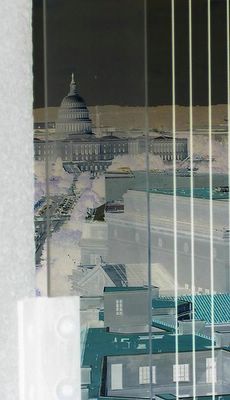TRANSIT: No Room to Read or Breathe
FOR THE SECOND MORNING IN A ROW, I haven't been able to find a Financial Times at any its distribution boxes in the Woodley Park area. First the FT raised the price of its pink paper to $1.50. And now this. (Yes, it's a great human tragedy. A day without the Lex column, music reviews by Ludovic Hunter-Tilney and Busines Life columns from Simon London is like a day without sunshine ... And my days have been dark.) I think that subtly, the FT is trying to shift everyone who wants to read the paper to a subscription, which is something that I might do.
Now, even if I were to have found a copy near my neighborhood Metrorail station, I would have had extreme trouble trying to read the thing on the Red Line. You see, I normally don't begin my morning commute until well after 10 a.m.; but I've been getting into the office much earlier than normal since Thanksgiving. And that puts me on one of the most congested sections of the Red Line toward the tail end of the morning rush: the Connecticut Avenue corridor. From Van Ness-UDC down to Farragut North, you really get to know your transit neighbors. When I lived in Glover Park and would take the D2 to Dupont Circle during the troubled transit times of 2003, delays, coupled with the intense crowding would highlight the Red Line problems of the Dupont Circle.
DUPONT CIRCLE IS THE LAST STATION on this section of the Red Line where a large number of neighborhood residents try to board the train. These are either local Dupont residents or bus riders from Glover Park, Georgetown and along the Massachusetts Avenue corridor up toward Ward Circle. This is where also a number of people from Montgomery County and Upper Northwest D.C. are disembarking at Dupont Circle and heading on up to the surface to their jobs in the office buildings in the immediate vicinity. Then you also have a large number of people continuing on toward downtown and especially Farragut North.
It is this section, between Dupont Circle and Farragut North where Red Liners must take an especially deep breath, and try to make room for the 1-2 minute crunch between the two stations. Then as the doom chimes at Farragut North, people exhale and a a healthy number of commuters leave the train, creating necessary room for everyone else who is continuing on toward Metro Center and other points downtown and beyond.
THIS CRUNCH IS MADE WORSE in colder weather when bulky coats, scarves and other accessories add an inch or two of extra padding -- padding that eventually adds up and takes room away from commuters. As I've written (regarding cold weather and bus riding), winter commutes can often be more painful than summer ones. Stir in a delay and the process of getting to work in the morning can be quite an ordeal. That's the reality on this section of the Red Line. I'd imagine there are other spots in the Metrorail system where this winter reality can be witnessed. (I'm looking at you Orange Line commuters in Virginia.)



0 Comments:
Post a Comment
<< Home